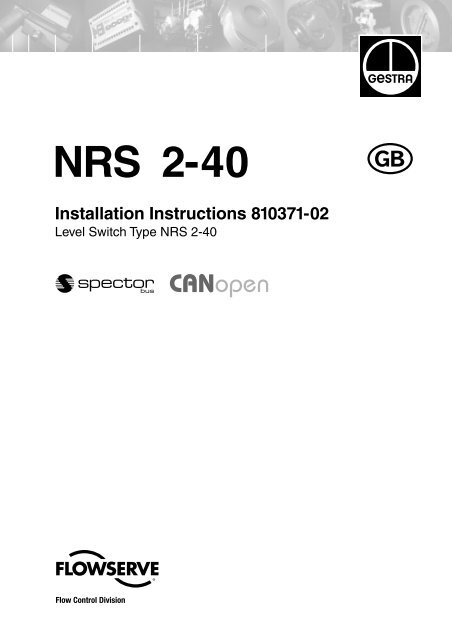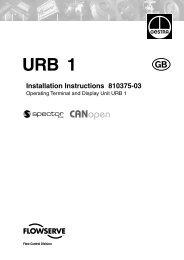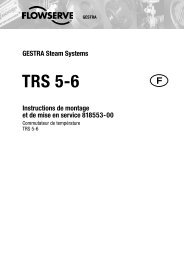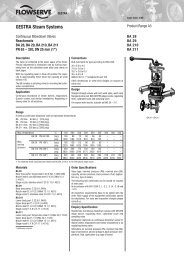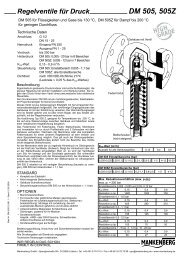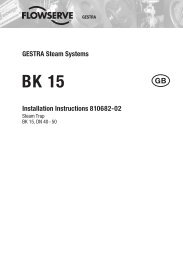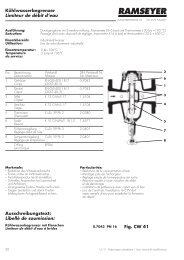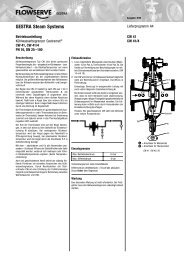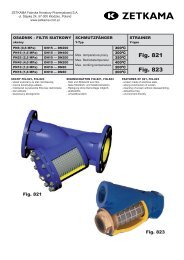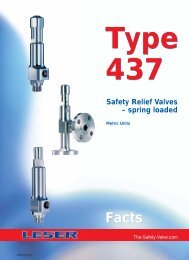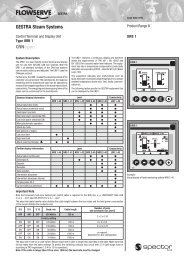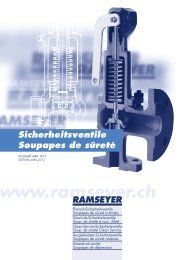NRS 2-40 - Flowserve Corporation
NRS 2-40 - Flowserve Corporation
NRS 2-40 - Flowserve Corporation
You also want an ePaper? Increase the reach of your titles
YUMPU automatically turns print PDFs into web optimized ePapers that Google loves.
<strong>NRS</strong> 2-<strong>40</strong><br />
<br />
Installation Instructions 810371-02<br />
Level Switch Type <strong>NRS</strong> 2-<strong>40</strong><br />
1
Contents<br />
Page<br />
Important Notes<br />
Usage to the intended purpose .......................................................................................7<br />
Safety note / Danger .......................................................................................................7<br />
Explanatory Notes<br />
Scope of supply ..............................................................................................................8<br />
System description .........................................................................................................8<br />
Function ..........................................................................................................................8<br />
Technical data .................................................................................................................9<br />
Installation<br />
<strong>NRS</strong> 2-<strong>40</strong> ......................................................................................................................10<br />
Example of installation .................................................................................................29<br />
Wiring<br />
Wiring diagram ...................................................................................................... 3, 4, 11<br />
Basic Adjustment<br />
CAN bus ........................................................................................................................12<br />
Node ID .........................................................................................................................12<br />
First / second control equipment ..................................................................................12<br />
Factory setting ..............................................................................................................13<br />
Commissioning<br />
<strong>NRS</strong> 2-<strong>40</strong> ......................................................................................................................14<br />
Control range ................................................................................................................14<br />
Establish control range ............................................................................................15, 16<br />
Establish switchpoints within adjusted control range ....................................................16<br />
Establish switchpoints ........................................................................................... 16 – 19<br />
Operation<br />
Normal operation ..........................................................................................................19<br />
Alarm .............................................................................................................................19<br />
High-level alarm ............................................................................................................19<br />
Low-level alarm .............................................................................................................19<br />
Relay test high/low (MAX/MIN) level .................................................................................20<br />
System Malfunctions<br />
Systematic fault finding procedure ................................................................................21<br />
Analysis of system malfunctions 1 – 4 ....................................................................22–24<br />
Operation Malfunctions<br />
Fault-finding list for troubleshooting ........................................................................25, 26<br />
Annex<br />
Factory set default node IDs .........................................................................................27<br />
Assigning / changing node IDs ................................................................................27, 28<br />
Declaration of conformity ..............................................................................................29<br />
2
Wiring Diagram<br />
Seite<br />
Relay Relay Relay Relay<br />
1 2 3 4<br />
MAX<br />
Fill/<br />
discharge<br />
control<br />
MIN<br />
Paired cable<br />
Paired cable<br />
Potentiometer<br />
optional output<br />
for actual value<br />
4-20 mA<br />
Fig. 1<br />
Terminating resistor<br />
120 Ω<br />
Control terminal<br />
URB 1<br />
Level switch<br />
<strong>NRS</strong> 2-<strong>40</strong><br />
Controller<br />
. . .<br />
Level electrodes<br />
NRG 26-<strong>40</strong><br />
Electrodes<br />
...<br />
CEP*)<br />
Power supply<br />
Terminating resistor<br />
120 Ω<br />
CAN data line<br />
Terminating resistor<br />
120 Ω<br />
*) CEP = central earthing point<br />
Fig. 2<br />
3
Wiring Diagram<br />
Discharge control –<br />
Pump OFF at low level (MIN)<br />
Pump contactor<br />
Fig. 3<br />
Paired cable<br />
Paired cable<br />
Potentiometer<br />
Terminating resistor<br />
120 Ω<br />
optional output<br />
for actual value<br />
4-20 mA<br />
Fill control – Pump OFF at high level (MAX)<br />
Pump contactor<br />
Fig. 4<br />
Paired cable<br />
Paired cable<br />
Potentiometer<br />
Terminating resistor<br />
120 Ω<br />
optional output<br />
for actual value<br />
4-20 mA<br />
4
Parts Drawing<br />
1<br />
Fig. 5<br />
7<br />
6<br />
5<br />
4<br />
3<br />
2<br />
A<br />
A<br />
B<br />
Fig. 6<br />
5
Key<br />
1<br />
Indicator LEDs<br />
Discharge control<br />
Fill control<br />
LED 1 – switchpoint 1<br />
High-level alarm<br />
High-level alarm<br />
LED 2 – switchpoint 2<br />
Pump ON<br />
Pump OFF<br />
LED 3 – switchpoint 3<br />
PUMP OFF<br />
Pump ON<br />
LED 4 – switchpoint 4<br />
Low-level alarm<br />
Low-level alarm<br />
2<br />
LED “Bus status”<br />
3<br />
LED “Power”<br />
4<br />
Enter button / test mode<br />
5<br />
Decrease button<br />
6<br />
Increase button<br />
7<br />
Program button<br />
8<br />
Code switch, 10 poles<br />
A<br />
Terminal strip<br />
B<br />
Screws for terminal strip<br />
6
Important Notes<br />
Usage for the intended purpose<br />
Use level switch <strong>NRS</strong> 2-<strong>40</strong> in conjunction with level electrode NRG 26-<strong>40</strong> only for<br />
liquid level monitoring and control.<br />
Safety notes<br />
The equipment must only be installed by qualified staff.<br />
Qualified staff are those persons who – through adequate training in electrical<br />
engineering, the use and application of safety equipment in accordance with<br />
regulations concerning electrical safety systems, and first aid & accident<br />
prevention – have achieved a recognised level of competence appropriate<br />
to the installation and commissioning of this device.<br />
Danger<br />
The terminal strip of the <strong>NRS</strong> 2-<strong>40</strong> is live during operation.<br />
This presents the danger of electric shock.<br />
Cut off power supply before fixing or removing the cover.<br />
7
Explanatory Notes<br />
Scope of supply<br />
<strong>NRS</strong> 2-<strong>40</strong><br />
1 Level switch type <strong>NRS</strong> 2-<strong>40</strong> (plug-in unit in plastic case with box terminals)<br />
1 Terminating resistor 120 Ω<br />
1 Operating manual<br />
Description<br />
Use level switch type <strong>NRS</strong> 2-<strong>40</strong> in combination with level electrode type<br />
NRG 26-<strong>40</strong> for level monitoring. The level switch has the following functions:<br />
■ Four liquid levels with one switchpoint each.<br />
■ High-level alarm, low-level alarm, pump ON, pump OFF, with one switchpoint each.<br />
■ Continuous level monitoring within control band defined by two preset limits.<br />
■ Actual-value output 4-20 mA (optional)<br />
■ Contact multiplication by connecting in parallel a second level switch <strong>NRS</strong> 2-<strong>40</strong><br />
without optional actual value output.<br />
The level data are transmitted via CAN-bus from the electrode NRG 26-<strong>40</strong> to the level<br />
switch.<br />
Function<br />
At regular intervals the level electrode type NRG 26-<strong>40</strong> sends a data telegram to the<br />
level switch <strong>NRS</strong> 2-<strong>40</strong>. The data transfer is effected by means of a CAN bus according<br />
to DIN ISO 11898. The transferred measuring data are then evaluated and assigned<br />
to the manually adjusted switchpoints. To guarantee the correct functioning and safety<br />
of the system the data transmitting cycle is constantly monitored by the level switch.<br />
When the CAN bus line is interrupted the level switch sends a visual signal to indicate<br />
a malfunction and the relays 1 and 4 will be instantaneously de-energized (alarm<br />
position).<br />
Additional functions, e.g. (de)-energizing delay times of the output relays<br />
(1 to 25 sec.) can be adjusted with the control terminal and display unit URB 1.<br />
8
Technical data<br />
Type approval no.<br />
<strong>NRS</strong> 2-<strong>40</strong>: TÜV · WR · 98-399<br />
Input / Output<br />
Interface for CAN bus to DIN ISO 11898 using CANopen<br />
Output – voltage supply for electrodes<br />
Power supply 24 V DC, short-circuit protected<br />
Analogue output 4 – 20 mA, load 500 Ω for display of actual value (optional).<br />
4 volt-free relay contacts.<br />
Max. contact rating with switching voltages of 24 V AC,<br />
115 V AC and 230 V AC: 4 A resistive, 0.75 A inductive at cos ϕ 0.5<br />
Max. contact rating with a switching voltage of 24 V DC: 4 A.<br />
Contact material: silver, hard-gold plated<br />
Interference suppression<br />
Provide contactor with an external RC combination (100 Ω / 47nF)<br />
Relay de-energizing delay<br />
Output “MIN”, “MAX” 3 s<br />
Indicators and adjustors<br />
1 red LED for switchpoint “High level” (MAX)<br />
1 red LED for switchpoint “Low level” (MIN)<br />
2 green LEDs for switchpoints “PUMP ON” and “PUM OFF”<br />
1 green LED “Power”<br />
1 red LED “Bus fault”<br />
1 ten-pole code switch for node ID and baud rate settings<br />
4 pushbuttons<br />
Supply voltage<br />
230 V ± 10 %, 50/60 Hz<br />
115 V ± 10 %, 50/60 Hz (option)<br />
Power consumption<br />
10 VA<br />
Protection<br />
Case: IP <strong>40</strong> to DIN ISO 60529<br />
Terminal strip: IP 20 to DIN ISO 60529<br />
Admissible ambient temperature<br />
0 °C to 55 °C<br />
Enclosure material<br />
Front panel: polycarbonate, grey<br />
Case: polycarbonate, black<br />
Weight<br />
Approx. 0.8 kg<br />
9
Installation<br />
<strong>NRS</strong> 2-<strong>40</strong><br />
Installation on mounting rail<br />
1. Clip level switch onto mounting rail 35 x 15 mm<br />
(DIN EN 50022).<br />
2. Align level switch, fig. 14, fig. 15<br />
Tool<br />
■ Screwdriver (5.5/100)<br />
Wiring<br />
Note that screened multi-core twisted-pair control cable is required, e. g.<br />
UNITRONIC ® BUS CAN 2 x 2 x ... 2 or RE-2YCYV-fl 2 x 2 x ... 2<br />
.<br />
The baud rate (data transfer rate) dictates the cable length between the bus nodes<br />
and the total power consumption of the measuring sensors dictates the conductor<br />
size.<br />
S 8 S 9 S 10<br />
OFF<br />
ON<br />
OFF<br />
ON<br />
OFF<br />
ON<br />
ON<br />
ON<br />
OFF<br />
OFF<br />
ON<br />
ON<br />
The baud rate is set via a code switch. Reduce baud rate if cable is longer than specified<br />
in the table. Make sure that all bus nodes have the same settings.<br />
To protect the switching contacts fuse circuit with 2.5 A (anti-surge fuse) or according to<br />
TRD regulations (1.0 A for 72 hrs operation).<br />
When a max. cable length of 1000 m is desired, make sure to modify the baud<br />
rate accordingly. Refer to page 27 and 28 for more details.<br />
Wiring diagram<br />
OFF<br />
OFF<br />
ON<br />
ON<br />
ON<br />
ON<br />
Baud rate<br />
See wiring diagrams on pages 3 and 4.<br />
Cable length<br />
250<br />
kBit/ s 125 m<br />
Factory setting<br />
Number of pairs<br />
and conductor size [mm 2 ]<br />
2 x 2 x 0.34<br />
125<br />
kBit/ s 250<br />
m<br />
2 x 2 x 0. 5<br />
100<br />
kBit/ s 335<br />
m<br />
2 x 2 x 0.75<br />
50<br />
kBit/ s 500 m<br />
20<br />
kBit/ s 1000 m<br />
10<br />
kBit/ s 1000 m<br />
on request, dependent on<br />
bus configuration<br />
UNITRONIC ® is a registered trademark of LAPP Kabelwerke GmbH, Stuttgart<br />
10
Wiring – continued –<br />
Tool<br />
Attention<br />
■ Wire equipment in series. Star-type wiring is not permitted.<br />
■ Interlink screens of control cables such that electrical continuity is<br />
ensured and connect them once to the central earthing point (CEP).<br />
■ To protect the switching contacts fuse circuit with T 2.5 A or<br />
according to TRD regulations (1.0 A for 72 hrs.).<br />
■ If two or more system components are connected in a CAN bus network,<br />
the first and last equipment have to be provided with a terminating<br />
resistor of 120 Ω. Fig. 2<br />
■ The CAN bus network must not be interrupted while operating.<br />
Any interruption will result in HIGH/LOW level alarm!<br />
If the level controller must be replaced, remove terminal<br />
strip A Fig. 6.<br />
Before removing the CAN-bus line from the terminal strip disconnect all<br />
relevant system components.<br />
Note<br />
■ Connect screen only to designated terminals.<br />
■ The loop resistance must be under 10 Ω.<br />
■ The rated voltage is stated on the name plate.<br />
■ When switching off inductive loads, voltage spikes are produced that<br />
may impair the operation of control and measuring systems. Inductive<br />
loads should therefore be provided with commercial arc suppressor<br />
RC combinations.<br />
■ In spite of correct wiring H.F. interference caused by the installation may<br />
lead to system breakdowns and malfunction messages. If necessary<br />
refer to the “Fault finding list for troubleshooting” on pages 25<br />
and 26.<br />
■ Screwdriver for slotted screws, size 2.5, completely insulated according to<br />
VDE 0680.<br />
11
Basic Adjustments<br />
CAN Bus<br />
All level and conductivity controllers and associated electrodes are interconnected by<br />
means of a CAN bus using the CANopen protocol. Every item of equipment features<br />
an electronic address (Node ID). The four-core bus cable serves as power supply and<br />
data highway for high-speed data exchange.<br />
The CAN address (Node ID) can be set between 1 and 123.<br />
The <strong>NRS</strong> 2-<strong>40</strong> is configured at our works and ready for service with other GESTRA<br />
system components without having to set the node ID.<br />
If several systems of the same kind are to communicate in one CAN bus<br />
network, be sure to assign one node ID for each individual system component.<br />
Refer to pages 27 and 28 for more details.<br />
Node ID<br />
First and second control equipment<br />
It is possible to operate the level switch <strong>NRS</strong> 2-<strong>40</strong> together with a second level<br />
switch <strong>NRS</strong> 2-<strong>40</strong> when 8 instead of only 4 switchpoints are required.<br />
The second level switch is termed “second control equipment” and must be<br />
ordered separately.<br />
The <strong>NRS</strong> 2-<strong>40</strong> can also be operated together with the level controller NRR 2-<strong>40</strong><br />
as “second control equipment”.<br />
The standard equipment <strong>NRS</strong> 2-<strong>40</strong> is termed “first control equipment 1”.<br />
Be sure to assign different node IDs for <strong>NRS</strong> 2-<strong>40</strong> (first control equipment),<br />
additional <strong>NRS</strong> 2-<strong>40</strong> (second control equipment) and NRR 2-<strong>40</strong> (controller)!<br />
The name plate of the <strong>NRS</strong> 2-<strong>40</strong> is marked “Control equipment 1” or<br />
“Control equipment 2”.<br />
12
Basic Adjustments – continued –<br />
Factory setting<br />
The level switch features the following factory set default values:<br />
■ Baud rate: 250 kb/s<br />
■ Control equipment: 1<br />
■ Node ID: 039<br />
■ Control equipment: 2<br />
■ Node ID: 0<strong>40</strong><br />
■ Switchpoint 1: 80 %<br />
■ Switchpoint 2: 60 %<br />
■ Switchpoint 3: <strong>40</strong> %<br />
■ Switchpoint 4: 20 %<br />
■ Relay with energizing delay switchpoint 1: 1s<br />
■ Relay with energizing delay switchpoint 2: 1s<br />
■ Relay with energizing delay switchpoint 3: 1s<br />
■ Relay with energizing delay switchpoint 4: 1s<br />
■ Relay with de-energizing delay switchpoint 1: 3s<br />
■ Relay with de-energizing delay switchpoint 2: 1s<br />
■ Relay with de-energizing delay switchpoint 3: 1s<br />
■ Relay with de-energizing delay switchpoint 4: 3s<br />
80 %<br />
60 %<br />
<strong>40</strong> %<br />
20 %<br />
100 %<br />
Fig. 7<br />
13
Commissioning<br />
<strong>NRS</strong> 2-<strong>40</strong><br />
Apply power to the unit.<br />
The four indicator LEDs flash rapidly.<br />
The LED “Power” lights up.<br />
The system test cycle takes about 2 sec.<br />
Indicator LEDs flash rapidly<br />
LED “Power” illuminated<br />
Control Range<br />
1 Desired control range [mm]<br />
2 Max. control range<br />
Establish the control range<br />
for your level monitoring<br />
application.<br />
1<br />
37<br />
NRG 26-<strong>40</strong><br />
2<br />
1<br />
Fig. 8<br />
26<br />
Lower control<br />
range limit<br />
14
Commissioning – continued –<br />
Establish control range<br />
Press button for 3 sec.<br />
Lower the liquid level in the vessel until the<br />
lower limit of the control range 1 is reached.<br />
Use button if you want to establish the<br />
upper limit of the desired control range first.<br />
If two control devices are used only one<br />
has to be adjusted.<br />
LEDs illuminated<br />
3 sec.<br />
LEDs flash slowly<br />
LED “Power”<br />
Press button briefly.<br />
Note:<br />
In the event of a system malfunction,<br />
the LED(s) “Bus status” and/or “Power”<br />
will be flashing rapidly when in<br />
program mode. Quit program mode<br />
and analyse the system malfunction<br />
(see pages 22 – 24).<br />
LEDs flash<br />
briefly<br />
LEDs flash slowly<br />
Press button briefly.<br />
The lower limit of the control range is<br />
now saved.<br />
LEDs illuminated<br />
LEDs flash slowly<br />
briefly<br />
Press button briefly.<br />
Raise liquid level until the upper limit of<br />
the desired control range 1 is reached.<br />
LEDs illuminated<br />
LEDs flash slowly<br />
briefly<br />
Press button<br />
briefly.<br />
LEDs flash<br />
LEDs flash slowly<br />
briefly<br />
15
Commissioning – continued –<br />
Establish control range – continued –<br />
Press button twice briefly.<br />
The upper limit of the desired control<br />
range is now saved.<br />
The <strong>NRS</strong> 2-<strong>40</strong> is back in operating<br />
mode.<br />
twice briefly<br />
Establish switchpoints within the adjusted control range<br />
1<br />
2<br />
3<br />
4<br />
5<br />
Switchpoint 1<br />
Switchpoint 2<br />
Switchpoint 3<br />
Switchpoint 4<br />
Adjusted control range<br />
NRG 26-<strong>40</strong><br />
1<br />
2<br />
3<br />
4<br />
5<br />
Fig. 9<br />
Establish switchpoints<br />
Press button briefly.<br />
Raise or lower the liquid level in the<br />
vessel until the desired value is reached.<br />
Use button if you want to establish a<br />
different switchpoint first.<br />
LED illuminated<br />
LEDs flash slowly<br />
briefly<br />
16
Commissioning – continued –<br />
Establish control range – continued –<br />
Press button<br />
briefly.<br />
LED illuminated<br />
LEDs flash slowly<br />
Lower or raise liquid level until<br />
switchpoint 4 within the adjusted control<br />
range is reached.<br />
Note:<br />
In the event of a system malfunction the<br />
LED(s) “Bus status” and/or “Power” will<br />
be flashing rapidly.<br />
briefly<br />
Press button<br />
briefly.<br />
LED illuminated<br />
LEDs flash slowly<br />
Switchpoint 4 is now saved.<br />
briefly<br />
Press button<br />
briefly.<br />
LED illuminated<br />
LEDs flash slowly<br />
Switchpoint 3 is now active.<br />
briefly<br />
Press button<br />
briefly.<br />
LED flashes<br />
LEDs flash slowly<br />
Raise liquid level until switchpoint 3<br />
within the adjusted control range is<br />
reached.<br />
briefly<br />
Press button<br />
briefly.<br />
LED illuminated<br />
LEDs flash slowly<br />
Switchpoint 3 is now saved.<br />
briefly<br />
17
Commissioning – continued –<br />
Establish control range – continued –<br />
Press button briefly.<br />
Switchpoint 2 is now active.<br />
LED illuminated<br />
LEDs flash slowly<br />
briefly<br />
Press button briefly.<br />
Raise liquid level until switchpoint 2<br />
within the adjusted control range is<br />
reached.<br />
LED illuminated<br />
LEDs flash slowly<br />
briefly<br />
Press button briefly.<br />
Switchpoint 2 is saved.<br />
LED illuminated<br />
LEDs flash slowly<br />
briefly<br />
Press button briefly.<br />
Switchpoint 1 is now active.<br />
LED illuminated<br />
LEDs flash slowly<br />
briefly<br />
Press button briefly.<br />
Raise liquid level until switchpoint 1<br />
within the adjusted control range is<br />
reached.<br />
LED illuminated<br />
LEDs flash slowly<br />
briefly<br />
18
Commissioning – continued –<br />
Establish control range – continued –<br />
Press button twice briefly.<br />
Switchpoint 1 is saved.<br />
The <strong>NRS</strong> 2-<strong>40</strong> is again in operating<br />
mode.<br />
LED illuminated<br />
twice briefly<br />
Operation<br />
Normal operation<br />
Normal operation – switching controller is<br />
working.<br />
All LEDs go out as soon as the setpoint is<br />
reached.<br />
The LED “Power” is illuminated.<br />
LEDs go out upon reaching the setpoint<br />
LED “Power” illuminated<br />
Alarm<br />
There are two alarm conditions:<br />
■ High-level alarm<br />
■ Low-level alarm<br />
High-level alarm<br />
LED 1 changes after the de-energizing<br />
delay from rapid flashing to lighting.<br />
flashes<br />
illuminated<br />
Low-level alarm<br />
LED 4 changes after the de-energizing<br />
delay from rapid flashing to lighting.<br />
flashes<br />
illuminated<br />
19
Operation – continued –<br />
Relay test high/low level alarm (MIN/MAX)<br />
Press button briefly.<br />
The test mode is active for 5 seconds.<br />
LEDs illuminated<br />
briefly<br />
Hold down button .<br />
LED 4 goes out.<br />
A low-level alarm is simulated for<br />
switchpoint 4.<br />
LED 4 goes out<br />
Hold down button .<br />
LED 1 goes out.<br />
A high-level alarm is simulated for<br />
switchpoint 1.<br />
LED 1 goes out<br />
System Malfunctions<br />
There are four types of system malfunctions that might occur in the level electrode and<br />
the level switch:<br />
■ Max. admissible temperature in electrode terminal box exceeded<br />
■ No or faulty communication between switching controller and electrode<br />
■ Fault in CAN bus<br />
■ Failure of 24 V power supply unit built in level controller <strong>NRS</strong> 2-<strong>40</strong><br />
Danger<br />
The terminal strip of the <strong>NRS</strong> 2-<strong>40</strong> is live during operation.<br />
This presents the danger of electric shock.<br />
Cut off power supply before mounting or removing the equipment.<br />
20
System Malfunctions – continued –<br />
Systematic Malfunction Analysis<br />
The sources of malfunctions occurring in CAN bus systems operating with several<br />
bus-based stations must be analysed systematically since faulty components or<br />
incorrect settings can give rise to negative interactions with intact bus devices in the<br />
CAN bus system. These unwanted interactions can cause error messages in fully<br />
functional bus devices, which will make fault detection even more difficult.<br />
We recommend the following systematic fault finding procedure:<br />
Step 1 (Start)<br />
Detach terminal strips<br />
in all sensing units of<br />
bus nodes.<br />
Level electrode<br />
Conductivity electrode<br />
Pressure sensor<br />
Temperature sensor<br />
Check<br />
Use fault-finding<br />
list to correct<br />
fault(s).<br />
Final test:<br />
have all faults<br />
been eliminated?<br />
Step 2<br />
Plug in terminal strips<br />
of the bus nodes<br />
e. g.<br />
<strong>NRS</strong> ...<br />
and<br />
NRG ...<br />
Check next system<br />
System<br />
Malfunction<br />
Use fault-finding list<br />
to identify the<br />
fault(s).<br />
Cut off power supply<br />
to the equipment.<br />
Step 3<br />
Apply mains voltage<br />
to bus nodes<br />
e. g.<br />
<strong>NRS</strong> ...<br />
and<br />
NRG ...<br />
System O.K.<br />
Detach terminal<br />
strips between bus<br />
nodes<br />
e. g.<br />
<strong>NRS</strong> ...<br />
and<br />
NRG ...<br />
21
System Malfunctions – continued –<br />
System malfunction 1<br />
LEDs flash slowly<br />
The four indicator LEDs flash slowly.<br />
High/low-level alarm<br />
Fault: The max. admissible temperature in the electrode terminal box is exceeded.<br />
Remedy: Insulate electrode flange to protect the equipment against heat radiation.<br />
As soon as the temperature drops below the max. admissible limit the equipment<br />
automatically returns to normal operation.<br />
System malfunction 2<br />
The four indicator LEDs flash rapidly.<br />
High/low-level alarm<br />
LEDs flash rapidly<br />
Fault: The CAN bus line between the nodes is interrupted.<br />
Remedy: Check wiring and terminals. Restart system<br />
Fault: Incorrect node ID(s).<br />
Remedy: Set correct nodes ID(s), referring to section “Basic Adjustments” or “Annex”.<br />
Disconnect the system from its power supply. After 5 sec. apply<br />
power and restart system.<br />
22
System Malfunctions – continued –<br />
System malfunction 3<br />
LED “Bus status” flashes slowly.<br />
LED flashes slowly<br />
Fault: Malfunction in CAN bus.<br />
Remedy: Restart system.<br />
LED “Bus status” flashes slowly.<br />
High/low-level alarm<br />
LED flashes slowly<br />
Fault: Data transfer in CAN bus interrupted.<br />
Remedy: The bus cables have to be correctly connected according to the wiring<br />
diagram (observe polarity!). Make sure that all end-of-line nodes are<br />
provided with 120 Ω terminating resistors, referring to the wiring diagram.<br />
Disconnect the system from its power supply. After 5 sec. apply power<br />
and restart system.<br />
Fault: The baud rate of one or more nodes is not set correctly.<br />
Remedy: Check baud rate settings of all bus nodes. The baud rates must be<br />
identical. Refer to section “Annex” for more details.<br />
Disconnect the system from its power supply. After 5 sec. apply power<br />
and restart system.<br />
Fault: The overall length of the bus cable does not correspond to the selected<br />
baud rate.<br />
Remedy: Change baud rate settings of all nodes according to the indications<br />
specified in “Annex”.<br />
Disconnect the system from its power supply. After 5 sec. apply power<br />
and restart system.<br />
23
System Malfunctions – continued –<br />
System malfunction 4<br />
LED “Power” flashes slowly.<br />
LED flashes slowly<br />
Fault: The power supply unit (PSU) is overloaded and may be misused for<br />
other components.<br />
Remedy: Check load of power supply unit. Be sure to use the PSU only for the<br />
voltage supply of bus-based network components.<br />
Disconnect the system from its power supply. After 5 sec. apply power<br />
and restart system.<br />
Fault: Power supply unit defective.<br />
Remedy: Replace power supply unit.<br />
24
Malfunctions<br />
Danger<br />
The terminal strip of the <strong>NRS</strong> 2-<strong>40</strong> is live during operation.<br />
This presents the danger of electric shock.<br />
Cut off power supply before mounting or removing the equipment.<br />
Fault-finding list for troubleshooting<br />
Device fails to work – indication of malfunction<br />
Fault: In spite of correct wiring and commissioning of the equipment an<br />
interference signal is indicated.<br />
Remedy: The interference signal is caused by H. F. interferences coming from the<br />
installation. For interference suppression of the voltage supply we supply<br />
ferrite rings, stock code 147253. The 230 V supply lines should be looped<br />
through the ferrite ring five to ten times. If several controllers are used in<br />
the system, they can be fed from the interference suppressed<br />
supply lines. For the intererence suppression of the bus line we supply<br />
hinged-shell ferrite rings, stock code 147254. The hinged-shell ferrite<br />
rings are clamped onto the bus line close to the terminal strip of the<br />
controller.<br />
Restart system after installation.<br />
Device fails to work – no function<br />
Fault: LED “Power” does not light up.<br />
Remedy: Apply power. Connect the equipment properly, referring to wiring<br />
diagrams.<br />
Device does not work properly<br />
Fault: Incorrect function at analogue output. The following actual value indicator<br />
shows incorrect values.<br />
Remedy: Correct the switchpoint settings and the control range settings of the<br />
electrode.<br />
Fault: Switchpoints and actual value indication drift continuously towards 100 %.<br />
Remedy: Deposits have accumulated on the electrode rod. Remove the level<br />
electrode and clean the electrode rod.<br />
Fault: A high-level alarm is raised although the liquid level is below high level.<br />
Remedy: Deposits have accumulated on the electrode rod.<br />
Clean the electrode rod.<br />
Defective electrode insulation. Replace level electrode.<br />
Fault: Liquid level below switchpoint “LOW LEVEL”, device fails to switch.<br />
Remedy: Check installation of level electrode and vent hole in the protection tube.<br />
If an external measuring pot is used make sure to open the isolating<br />
valves.<br />
25
Malfunctions – continued –<br />
Fault-finding list for troubleshooting– continued –<br />
Fault: “HIGH-LEVEL” switchpoint exceeded – no indication.<br />
Remedy: Level switch defective. Replace equipment.<br />
If faults occur that are not listed above or cannot be corrected, please contact our<br />
service centre or authorized agency in your country.<br />
26
Annex<br />
Danger<br />
The terminal strip of the <strong>NRS</strong> 2-<strong>40</strong> is live during operation.<br />
This presents the danger of electric shock.<br />
Cut off power supply before mounting or removing the equipment.<br />
Factory set default node IDs<br />
Switching<br />
controller<br />
Level<br />
electrode<br />
The individual node IDs must be manually adjusted on the equipment.<br />
Please observe the installation instructions of the device in question.<br />
Assigning / changing node ID<br />
If several systems of the same kind are to communicate in one CAN bus network, be<br />
sure to assign one node ID for each individual system component (e. g. controller).<br />
Detach terminal strips A in order to change the code switch setting 8 .<br />
Attention<br />
■ Do not assign the same node ID twice within the CAN bus network.<br />
8<br />
Fig. 10<br />
27
Annex – continued –<br />
Node ID<br />
S1 ON 1<br />
S2 ON 2<br />
S3 ON 4<br />
S4 OFF 8<br />
S5 OFF 16<br />
S6 ON 32<br />
S7 OFF 64<br />
Fig. 11 (Factory setting)<br />
39 Node ID 74<br />
S1 OFF 1<br />
S2 ON 2<br />
S3 OFF 4<br />
S4 ON 8<br />
S5 OFF 16<br />
S6 OFF 32<br />
S7 ON 64<br />
Fig. 12 (Example)<br />
S8 S9 S0 Baud rate<br />
OFF ON OFF 250 kBit/s<br />
ON ON OFF 125 kBit/s<br />
OFF OFF ON 100 kBit/s<br />
ON OFF ON 50 kBit/s<br />
OFF ON ON 20 kBit/s<br />
ON ON ON 50 kBit/s<br />
Fig. 13 (Factory setting 250 kBit/s)<br />
Cable length<br />
125 m<br />
250 m<br />
335 m<br />
500 m<br />
1000 m<br />
1000 m<br />
28
Annex – continued –<br />
Declaration of conformity<br />
We hereby declare that the equipment <strong>NRS</strong> 2-<strong>40</strong> conforms to the following<br />
European guidelines:<br />
■ LV guideline 73/23/eec version 93/68/eec<br />
■ EMC guideline 89/336/eec version 93/68/eec<br />
which are based on the following harmonised standards:<br />
■ LV standard DIN EN 50178<br />
■ EMC standard DIN EN 50 081-2, DIN EN 61 000-6-2<br />
This declaration is no longer valid if modifications are made to the equipment without<br />
consultation with us.<br />
Bremen, 23 rd July 2002<br />
GESTRA GmbH<br />
Head of the Design Dept.<br />
Uwe Bledschun<br />
(Academically qualified engineer)<br />
Quality Assurance Manager<br />
Lars Bohl<br />
(Academically qualified engineer)<br />
Key<br />
A<br />
C<br />
Terminal strips<br />
Supporting rail 35 x 15 to DIN EN 50022<br />
29
Example of Installation<br />
100<br />
C<br />
A<br />
73<br />
118<br />
Fig. 14<br />
A<br />
Fig. 15<br />
20 20<br />
30
For your notes<br />
31
GESTRA Gesellschaften · GESTRA Companies · Sociétés GESTRA · Sociedades Gestra · Società GESTRA<br />
Vertretungen weltweit · Agencies all over the world · Représentations dans le monde entier · Representaciones en todo el mundo · Agenzie in tutto il mondo<br />
Great Britain<br />
<strong>Flowserve</strong> Flow Control (UK) Ltd.<br />
Burrel Road, Haywards Heath<br />
West Sussex RH 16 1TL<br />
Tel. 00 44 14 44 / 31 44 00<br />
Fax 00 44 14 44 / 31 45 <strong>40</strong><br />
E-mail: sales@flowserve.com<br />
Italia<br />
<strong>Flowserve</strong> S.p. A<br />
Divisione Italgestra<br />
Via Prealpi, 30 – 20032 Cormano (MI)<br />
Tel. 00 39 02 / 66 32 51<br />
Fax 00 39 02 / 66 32 55 60<br />
E-mail: info@italgestra.it<br />
France<br />
<strong>Flowserve</strong> Flow Control S. A. S.<br />
10 Avenue du Centaure, BP 8263<br />
F-95801 CERGY PONTOISE CEDEX<br />
Tél. 0 03 31 / 34 43 26 60<br />
Fax 00331/34432687<br />
E-mail: gnation@flowserve.com<br />
Portugal<br />
<strong>Flowserve</strong> Portuguesa, Lda.<br />
Av. Dr. Antunes Guimarães, 1159<br />
Porto 4100-082<br />
Tel. 0035122/6198770<br />
Fax 00351 22 / 6 10 75 75<br />
E-mail: gestra@gestra.pt<br />
España<br />
GESTRA ESPAÑOLA S.A.<br />
Luis Cabrera, 86-88<br />
E-28002 Madrid<br />
Tel. 00 34 91 / 5 152 032<br />
Fax 003491/4136747; 5152036<br />
E-mail: gestra@gestra.es<br />
®<br />
GESTRA GmbH<br />
P. O. Box 10 54 60, D-28054 Bremen, Münchener Str. 77, D-28215 Bremen<br />
Telephone +49 (0) 421 35 03 - 0, Fax +49 (0) 421 35 03 - 393<br />
E-Mail gestra.gmbh@flowserve.com, Internet www.gestra.de<br />
A Unit of <strong>Flowserve</strong> <strong>Corporation</strong><br />
810371-02/903 · ©2000 GESTRA GmbH · Bremen · Printed in Germany<br />
32


